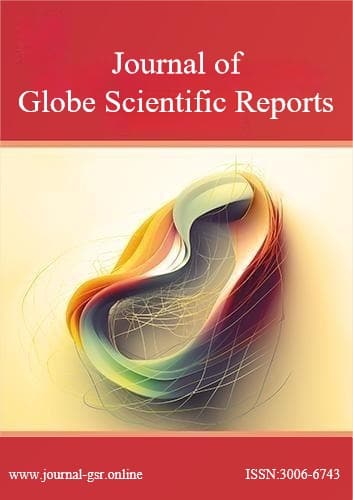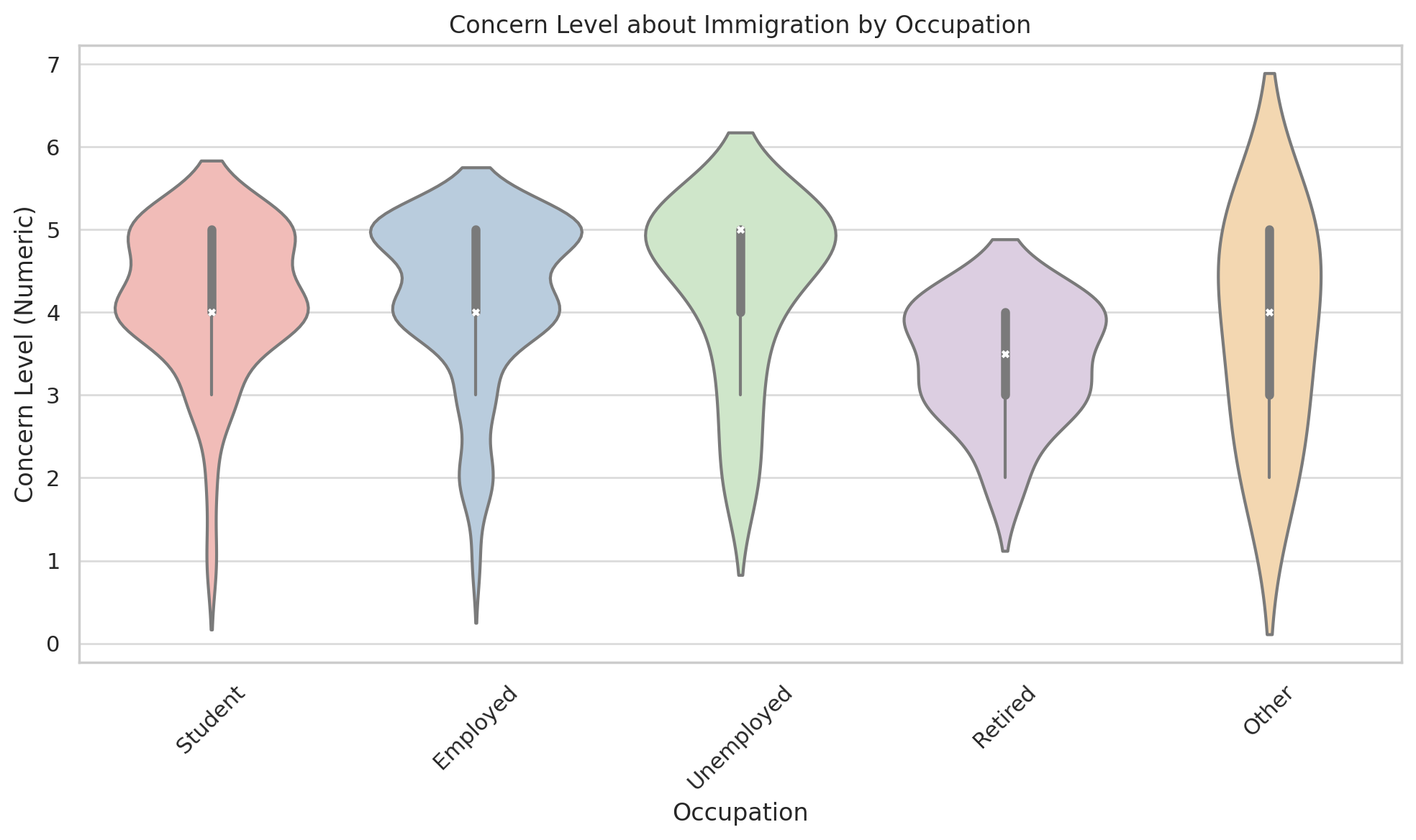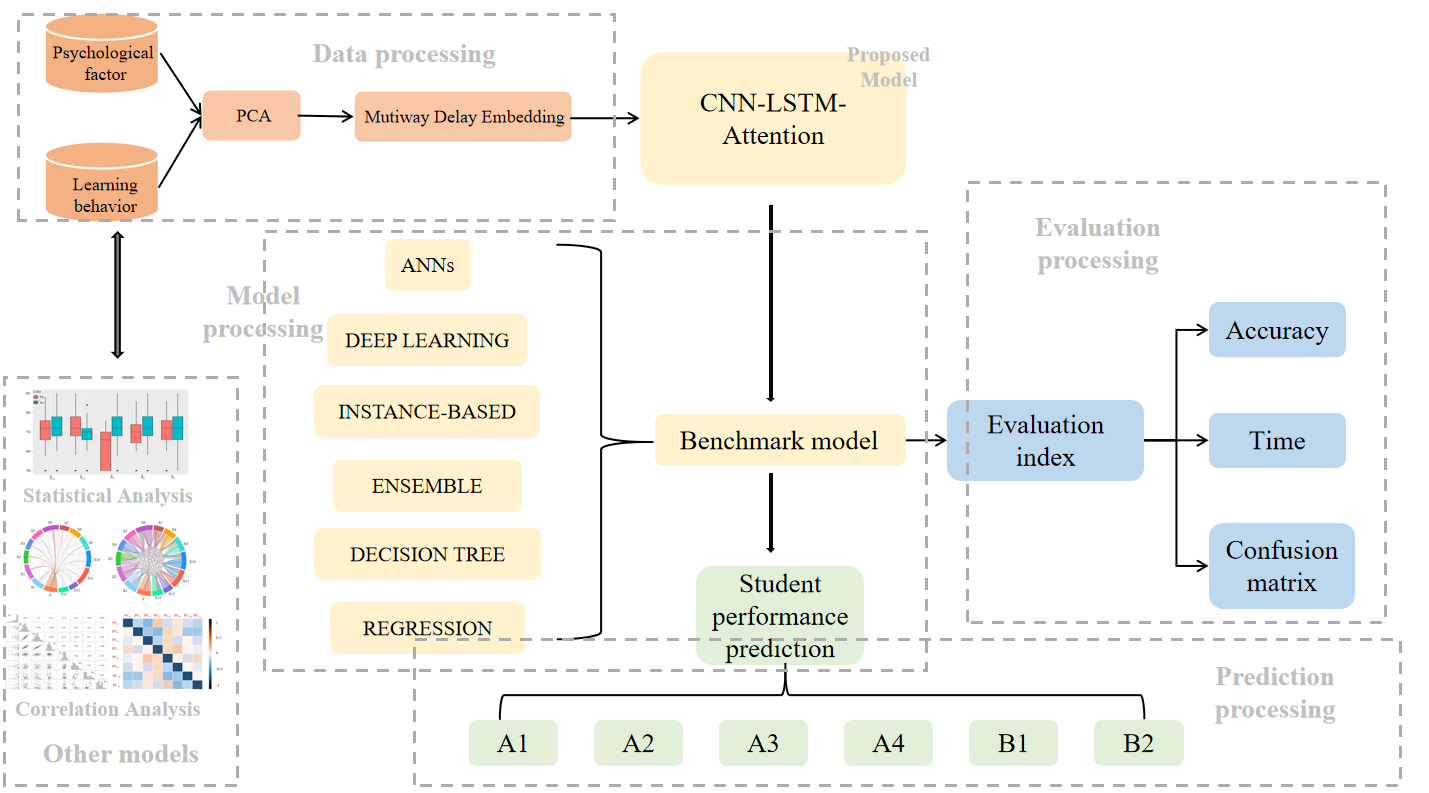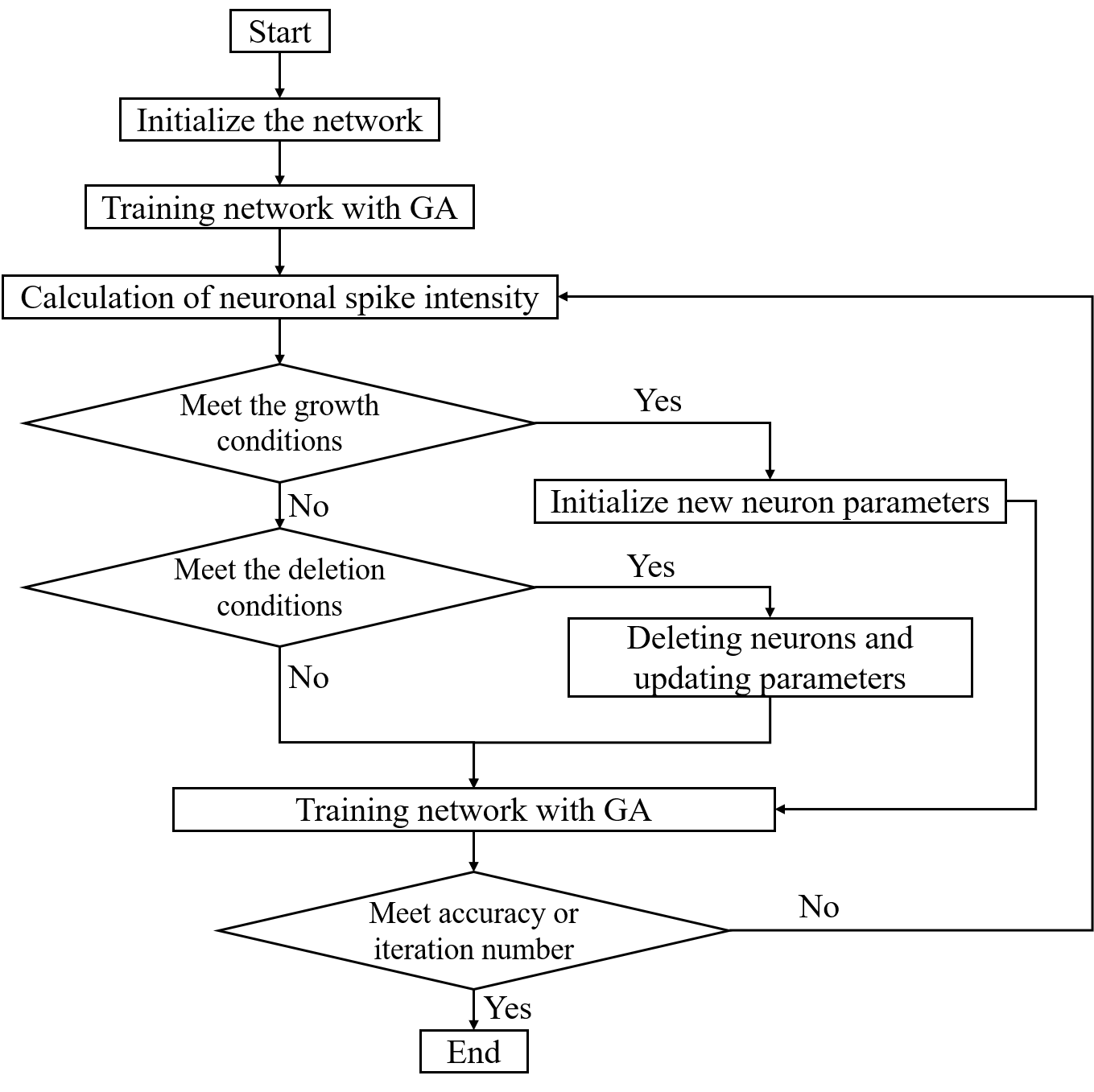 An open access journal
An open access journal
Case Study: Predicting Academic Success in Business English through Learning Behavior and Psychological Support Analysis with Machine Learning
Abstract
This report takes learning behavior and psychological support as the factors to predict the students' academic performance. A total of 13 factors were selected at the initial stage. Firstly, PCA and MDT algorithms were used for data preprocessing, and we used CNN to extract deep student behavior features. Then, the maximum pooling approach is used to pick the significant features; next, the selected features are used as the input of LSTM. A temporal attention mechanism is introduced at the output of LSTM to allocate attention weights for different weekly student behavior characteristics. This paper divides students' academic performance into several score intervals and makes a multi-classification prediction. This study uses 39 algorithms based on six types to predict the student's academic performance. The result shows that: (1) The average prediction accuracy based on the deep learning model is the highest (85.46%) in the six types of models; (2) The accuracy of the LSTM algorithm (88.36%) outperformed all the benchmark models. (3) The attention mechanism introduced can effectively improve the model's prediction accuracy; the proposed model in this paper outperformed all the benchmark models. Furthermore, the statistical analysis found that (1) Students who have academic confidence (confidence in teachers, courses, and themselves) may obtain higher academic performance; (2) A clear learning motivation is essential to final academic performance; (3) Lack of confidence in others in the study group may ultimately improve students' academic performance by encouraging them to work harder.
Show Figures
Share and Cite
Article Metrics
References
- Al-Barrak, M. A., & Al-Razgan, M.. (2016). Predicting students final gpa using decision trees: a case study. International Journal of Information and Education Technology, 6(7), 528-533.
- Aljohani, N. R., Fayoumi, A., & Hassan, S. U.. (2019). Predicting at-risk students using clickstream data in the virtual learning environment. Sustainability, 11(24), 7238.
- Amra, I. A. A., Maghari, A. Y. A.. (2017). Students performance prediction using KNN and Naive Bayesian; proceedings of the 8th International Conference on Information Technology, ICIT 2017, May 17, 2017 May 18, 2017, Amman, Jordan, F. Institute of Electrical and Electronics Engineers Inc.
- Antoninis, M., April, D., Barakat, B., Bella, N., & Zekrya, L.. (2020). All means all: an introduction to the 2020 global education monitoring report on inclusion. Prospects, 49(3-4), 1-7.
- Arsad, P. M., Buniyamin, N., & Manan, J.. (2014). A neural network students' performance prediction model (NNSPPM). IEEE International Conference on Smart Instrumentation. IEEE.
- Ashenafi, M. M., Riccardi, G., Ronchetti, M.. (2015). Predicting students' final exam scores from their course activities. Frontiers in Education Conference. IEEE.
- Asif, R., Merceron, A., Ali, S. A., & Haider, N. G.. (2017). Analyzing undergraduate students' performance using educational data mining. Computers & Education, 113(oct.), 177-194.
- Baradwaj, B. K., & Pal, S.. (2011). Mining educational data to analyze students' performance. International Journal of Advanced Computer Science & Application, 2(6), 63-69.
- Baurle, R. A., Tam, C. J., Edwards, J. R., & Hassan, H. A.. (2003). Hybrid simulation approach for cavity flows: blending, algorithm, and boundary treatment issues. Aiaa Journal, 41(8), 1463-1480.
- Breiman, & Leo. (1996). Bagging predictors. Machine Learning, 24(2), 123-140.
- Breiman, & Leo. (1996). Stacked regressions. Machine Learning, 24(1), 49-64.
- Chen, S. H., Hwang, S. H., & Wang, Y. R.. (1998). An rnn-based prosodic information synthesizer for mandarin text-to-speech. IEEE Transactions on Speech & Audio Processing, 6(3), 226-239.
- Claver, F., LM Martínez-Aranda, Conejero, M., & Gil-Arias, A.. (2020). Motivation, discipline, and academic performance in physical education: a holistic approach from achievement goal and self-determination theories. Frontiers in Psychology, 11, 1808.
- Collins, M., Schapire, R. E., & Singer, Y.. (2002). Logistic regression, adaboost and bregman distances. Machine Learning, 48(1/2/3), 253-285.
- Conference, I.. (1996). Proceedings of the Thirteenth National Conference on Artificial Intelligence and the Eighth Innovative Applications of Artificial Intelligence Conference. AAAI Press, MIT Press.
- Corrigan, O., & Smeaton, A. F.. (2017). A course agnostic approach to predicting student success from vle log data using recurrent neural networks. Springer, Cham.
- Costa, E. B., Fonseca, B., Santana, M. A., de, A. F. F., & Rego, J.. (2017). Evaluating the effectiveness of educational data mining techniques for early prediction of students' academic failure in introductory programming courses. Computers in Human Behavior, 73, 247-256.
- Cun, Y. L., Boser, B., Denker, J. S., Henderson, D., & Jackel, L. D.. (1990). Handwritten digit recognition with a back-propagation network. Advances in neural information processing systems, 2(2), 396--404.
- Danielle, E., Borriello, G. A., & Field, A. P.. (2018). A review of the academic and psychological impact of the transition to secondary education. Frontiers in Psychology, 9, 1482-.
- Delen, D., Kuzey, C., & Uyar, A.. (2013). Measuring firm performance using financial ratios: a decision tree approach. Expert Systems with Applications, 40(10), 3970-3983.
- Deng, S., Wang, C., Wang, M., & Sun, Z.. (2019). A gradient boosting decision tree approach for insider trading identification: an empirical model evaluation of china stock market. Applied Soft Computing, 83, 105652.
- Espinosa, A., Tikhonov, A., & Jorgenson, J.. (2016). Increasing retention in mathematics courses: the role of self-confidence in mathematics on academic performance.
- Fok, W., He, Y. S., Yeung, H., Law, K. Y., Cheung, K., & Ai, Y., et al. (2018). Prediction model for students' future development by deep learning and tensorflow artificial intelligence engine. (pp.103-106)..
- Friedman, J., Hastie, T., & Tibshirani, R.. (2000). Additive logistic regression: a statistical view of boosting (with discussion and a rejoinder by the authors). Annals of Statistics, 28(2), 337-374.
- Fuente, J., Sander, P., & Putwain, D.. (2013). Relationship between undergraduate student confidence, approach to learning and academic performance: the role of gender. Revista de psicodidáctica, 18, págs. 375-393.
- Gaddam, S. R., Phoha, V. V., & Balagani, K. S.. (2007). K-means+id3: a novel method for supervised anomaly detection by cascading k-means clustering and id3 decision tree learning methods. IEEE TRANS KNOWL DATA ENG, 2007,19(3)(-), 345-354.
- Graves, A., & Schmidhuber, J.. (2005). Framewise phoneme classification with bidirectional lstm and other neural network architectures. Neural Networks, 18( 5–6), 602-610.
- Group, I. E.. (2019). Selected drivers of education quality. World Bank Publications.
- Gurmeet Kaur and Williamjeet Singh. (2016). Optimal Selection of Factors Influencing Student Academic Performance in Educational Data Mining. Research Cell: An International Journal of Engineering Sciences, 22(0), pp. 386-393..
- Kaden, M., Lange, M., Nebel, D., Riedel, M., Geweniger, T., & Villmann, T.. (2014). Aspects in classification learning - review of recent developments in learning vector quantization. Foundations of Computing and Decision Sciences, 39(2), 79--105.
- Karthikeyan, V. G., Thangaraj, P., & Karthik, S.. (2020). Towards developing hybrid educational data mining model (hedm) for efficient and accurate student performance evaluation. Soft Computing, 24(5).
- Keerthi, S. S., Shevade, S. K., Bhattacharyya, C., & Murthy, K.. (2014). Improvements to platt's smo algorithm for svm classifier design. Neural Computation, 13(3), 637-649.
- Kohonen, T. . (1990). The self-organizing map. IEEE Proc Icnn, 1(1-3), 1-6.
- Krammer, G. , Pflanzl, B., Mayr, J.. (2018). Using students' feedback for teacher education: measurement invariance across pre-service teacher-rated and student-rated aspects of quality of teaching. Assessment & Evaluation in Higher Education, 1-14..
- Li L, Wu B and Patwary AK.. (2022). The Psychosocial Factors Affecting Chinese Outbound Exchange and Mobility Students’ Academic Performance During COVID-19. Front. Psychol. 13:872516. doi: 10.3389/fpsyg.2022.872516
- Liaw, A., & Wiener, M.. (2002). Classification and regression by randomforest. R News, 23(23).
- Nakanishi, J., Farrell, J. A., & Schaal, S.. (2005). Composite adaptive control with locally weighted statistical learning. Neural Networks, 18(1), 71-90.
- Neissi, L., Golabi, M., & Gorman, J. M.. (2020). Spatial interpolation of sodium absorption ratio: a study combining a decision tree model and gis. Ecological Indicators, 117, 106611.
- Notice of the Ministry of Education on the Issuance of the Action Plan of Education Informatization 2.0 [J]. Bulletin of the Ministry of Education of the People's Republic of China, 2018(04): 118-125.
- Notice of the State Council on the issuance of an action plan to promote the development of big data [J]. Bulletin of the State Council of the People's Republic of China,2015(26):26-35.
- Oeda, S., & Hashimoto, G.. (2017). Log-data clustering analysis for dropout prediction in beginner programming classes. Procedia Computer Science, 112, 614-621.
- Oyelade, O. J., Oladipupo, O. O., Obagbuwa, I. C.. (2010). Application of k means clustering algorithm for prediction of students academic performance. International Journal of Computer Science & Information Security, 7(1), S39..
- Paik, J. K., & Katsaggelos, A. K.. (1992). Image restoration using a modified hopfield network. IEEE Transactions on Image Processing, 1(1), 49-63.
- Parneet, Kaur., Manpreet, Singh, Gurpreet, Singh, et al. (2015). Classification and prediction based data mining algorithms to predict slow learners in education sector. Procedia Computer Science, 57(6): 500-508.
- Perez-Godoy, M. D., Fernandez, A., Rivera, A. J., & Jesus, M. J. D.. (2010). Analysis of an evolutionary rbfn design algorithm, co2rbfn, for imbalanced data sets. Pattern Recognition Letters, 31(15), 2375-2388.
- Polyzou, A., & Karypis, G.. (2016). Grade Prediction With Models Specific to Students and Courses. International Journal of Data Science and Analytics, 2(3):159-171.
- Poropat, & Arthur, E.. (2009). A meta-analysis of the five-factor model of personality and academic performance. Psychological Bulletin, 135(2), 322-338.
- Rifat, M., Imran, A. A., & Badrudduza, A.. (2019). EduNet: A Deep Neural Network Approach for Predicting CGPA of Undergraduate Students. 2019 1st International Conference on Advances in Science, Engineering and Robotics Technology (ICASERT).
- Rodrigues, M. W., Isotani, S., & LE Zárate. (2018). Educational data mining: a review of evaluation process in the e-learning. Telematics & Informatics, 35(6), 1701-1717.
- Romero, C., & Ventura, S.. (2020). Educational data mining and learning analytics: An updated survey. Wiley Interdisciplinary Reviews-Data Mining and Knowledge Discovery, 10(3).
- Rosenblatt, & F. (1958). The perceptron: a probabilistic model for information storage and organization in the brain. Psychological Review, 65, 386-408.
- Roska, T., & Chua, L. O.. (2015). The cnn universal machine: an analogic array computer. IEEE Transactions on Circuits & Systems II Analog & Digital Signal Processing, 40(3), 163-173.
- Salakhutdinov, R., & Hinton, G. E.. (2009). Deep boltzmann machines. Journal of Machine Learning Research, 5(2), 1967 - 2006.
- Sankaralingam, S. K., Nagarajan, N. S., & Narmadha, A. S.. (2020). Energy aware decision stump linear programming boosting node classification based data aggregation in wsn. Computer Communications, 155(Apr.), 133-142.
- Sarda-Espinosa, A., Subbiah, S., & Bartz-Beielstein, T.. (2017). Conditional inference trees for knowledge extraction from motor health condition data. Engineering Applications of Artificial Intelligence, 62(Jun.), 26-37.
- Shi, Q., Yin, J., Cai, J., Cichocki, A., & Zeng, J.. (2020). Block Hankel Tensor ARIMA for Multiple Short Time Series Forecasting. (Vol.34, pp.5758-5766).
- Shin, Hoo-Chang, Orton, Matthew, R., Collins, & David, J., et al. (2013). Stacked autoencoders for unsupervised feature learning and multiple organ detection in a pilot study using 4d patient data. IEEE Transactions on Pattern Analysis & Machine Intelligence, 35(8), 1930-1943.
- Sweeney, M., Lester, J., & Rangwala, H.. (2015). Next-term student grade prediction. IEEE International Conference on Big Data. IEEE.
- Taieb, S. B., & Hyndman, R. J.. (2014). A gradient boosting approach to the kaggle load forecasting competition. International Journal of Forecasting, 30(2), 382-394.
- Tair, M. , Elhalees, A. M. . (2012). Mining educational data to improve students' performance: a case study. International Journal of Information & Communication Technology Research, 2(2), 140-146.
- Tom, M., & Mitchell. (1999). Machine learning and data mining. Communications of the ACM, 42(11), 30-36.
- Tsitsiklis, J. N., Bertsekas, D. P., & Athans, M.. (1986). Distributed asynchronous deterministic and stochastic gradient optimization algorithms. IEEE Transactions on Automatic Control, 31(9), 803-812.
- United States Department of Education. Enhancing Teaching and Learning Through Data Mining and Learning Analytics - Karen Cator, U.S. Department of Education, Office of Educational.[EB/OL], https://www.ed.gov/.
- Wang, L., Zhang, Y., Yao, Y., Xiao, Z., & Wang, J.. (2021). Gbrt-based estimation of terrestrial latent heat flux in the haihe river basin from satellite and reanalysis datasets. Remote Sensing, 13(6), 1054.
- Xing, W., Guo, R., Eva, P., & Sean, G.. (2015). Participation-based student final performance prediction model through interpretable genetic programming: integrating learning analytics, educational data mining and theory. Computers in Human Behavior, 47(jun.), 168-181.
- Ye, C., & Biswas, G.. (2014). Early prediction of student dropout and performance in moocs using higher granularity temporal information. Journal of Learning Analytics, 1(3), 169-172.
- Yokota, T.. (2018). Missing Slice Recovery for Tensors Using a Low-rank Model in Embedded Space.
- Zhang, H. X., Xu, W. X., Zhang, Y., & Chen, C. F.. (2012). The blind demodulation scheme based on mp algorithm in chirp-bok uwb system. Journal of China Universities of Posts & Telecommunications, 19(Suppl 1), 66-70.
- Zhang, M. L., & Zhou, Z. H.. (2007). Ml-knn: a lazy learning approach to multi-label learning. Pattern Recognition, 40(7), 2038-2048.
- Zhang, Y, N.. (2016). Research on the application of big data in education [D]. East China Normal University.
- Zhiyun Ren and Huzefa Rangwala and Aditya Johri. (2016). Predicting Performance on MOOC Assessments using Multi-Regression Models.. CoRR, abs/1605.02269.
- Zhou, Q., Mou, C., Yang, D.. (2015). A review of research advances in educational data mining. Journal of Software, 26(11):3026-3042.
- Zou, M., & Conzen, S. D.. (2005). A new dynamic bayesian network (dbn) approach for identifying gene regulatory networks from time course microarray data. Bioinformatics(1), 71-79.






